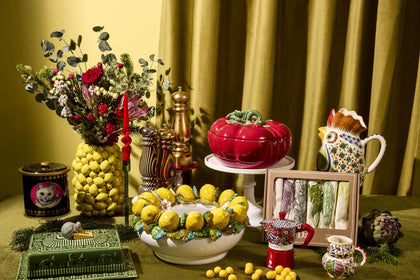
How To Make Your Own Kimchi
-
300 minutes prep time
-
0 minutes cook time
-
Intermediate

This is a quick and simple kimchi recipe - and more delicious than any ready made other kimchi recipes we’ve found. We tried over twenty different kimchi recipes before developing this one. Including time spent learning kimchi making in South Korea. It's also made with ingredients widely available in the UK.
Kimchi is often thought of as the national dish of Korea. Kimchi is one of the most popular fermented foods, known for its unique taste and health benefits. Fermented foods like kimchi are known for their unique flavors and health benefits.
Making homemade kimchi allows you to customize flavors and control the fermentation process according to your personal taste preferences. Kimchi changes flavour over time as it continues to ferment, even when it is kept in the refrigerator.
If you're ready to make kimchi, check out the ingredients & methods here.
What is Kimchi?
Kimchi is a traditional Korean side dish made from fermented vegetables, usually napa cabbage or daikon, seasoned with a variety of spices.
The word “kimchi” literally means “salted fermented vegetables” in Korean. This iconic dish has been a staple in Korean cuisine for centuries. And so it isn't always spicy! 'White kimchi' are fermented vegetables without the added 'gochugaru' red pepper powder, or spice.
The flavours of kimchi come from the fermentation at room temperature, as well as Korean red pepper powder's spicy kick.
Known for its crunchy texture and vibrant taste, kimchi is not just delicious, but also a testament to Korea’s rich cultural heritage.
How long should the kimchi fermentation process take?
The kimchi flavours will change over time:
- 0-12 hours: Tuck in the moment the kimchi is made, and red pepper, raw garlic and ginger are the strongest flavours.
- 12-36 hours: After a day or two, there is a slight fizz but the red pepper powder and kick remain. You'll taste the kimchi each day to decide when to move it to the fridge.
- 36 hours to 1 week: In the fridge, the flavours should stay fairly consistent. The fermented vegetables will become slightly more sour, but the flavors can seem more balanced.
- 2 weeks +: The kimchi will become more sour and the cabbage will soften. This is when you might prefer to use the kimchi in cooking, for example this kimchi jiggae stew recipe or kimchi pancakes recipe.
What vegetables go into kimchi?
Popular vegetables for kimchi making include:
- Napa or Chinese cabbage
- Carrot
- Daikon, white Asian radish
- Cucumber, for a shorter ferment summer cucumber kimchi
Addition crunchy vegetables bring more texture and can enhance the overall taste of the dish.
What water to use when making kimchi?
There is a much debate in fermentation about what water to use if you're adding some - the concern is that chlorine in your water might kill any 'good bacteria', and prevent fermentation from happening.
If you're in a high chlorine area, you can use bottled water instead of tap water. However, we've tested the recipe with London tap water (high in chlorine) and it works well. No need to use bottled water!
What should I make kimchi in?
You can make kimchi in most containers, however it is important to keep the cabbage submerged in liquid to help prevent mould growth. There are three options:
1. Specialist E-Jen Brining Container
Our top recommendation is an E-Jen Brining & Fermentation Container, used in households across Korea. It has 3 benefits:
- Handy rectangular shape, so it takes up very little space in the fridge.
- There is a carbon filter to allow air circulation, but prevent the smell overpowering your fridge.
- Built in vacuum seal layer that you can move down as you eat the kimchi, so it is always pressed down, and has limited air contact.
2. A tall glass jar
Something tall and narrow is best, like a 1 litre clip top jar. There are a few options for keeping the cabbage submerged beneath the brine:
- A fermentation weight or dish: To help keep the cabbage under liquid, you could rest a small food-safe weight or small sauce dish on top.
- A bag of salt brine: Sandor Katz, author of The Art of Fermentation, mentions using a small sealed plastic food storage bag filled with a 2% salt solution and salty brine (100ml water with 2g salt dissolved in it) resting on top (the brine is in case it leaks into your vegetables).
- A cabbage leaf: More traditionally the surface is covered with a whole cabbage leaf to help keep the other ingredients submerged. However, we'd recommend combining this with a weight!
3. A food safe plastic bag
Alternative you could even use a food-safe plastic bag to make kimchi in, which is how kimchi-making is taught in one cookery school in Seoul, South Korea. If you keep squeezing air out, then no need to hold the cabbage under the surface! In the early stages of fermentation at room temperature, just press out any extra air and reseal.
If you do make kimchi in a plastic bag, you might prefer to keep the bag in a sealed box in the fridge to reduce the garlic-fish odours - plastic bags of kimchi tend to smell more strongly than glass jars!
Or if you want something reusable, perhaps try one of these silicone sandwich bags.
Can you make vegan kimchi?
Yes! Pro pickler, Pao Liu explains: “I created my signature vegan kimchi by replacing fish sauce with wakame seaweed. It’s one of my top-selling products. I wanted to create a good kimchi, that everyone can enjoy, whether they are vegan or not. I brine and drain Chinese leaf with wakame seaweed, along with spring onion, leek and carrot. Then I make the paste using Korean chilli flakes and garlic powder, ginger, onion and pear. I mix everything and pack it into buckets to ferment.”
Vegan kimchi is a great way to enjoy the flavors of Korean cuisine without using animal products. Just make sure you follow a special recipe for Vegan kimchi, that contains the right amount of salt (you can't just remove the fish sauce from this recipe!).
Read: Pao's guide to fermenting for beginners.
A note about fish sauce in kimchi
Fish sauce is renowned for its umami qualities, which add depth and complexity to dishes.
In kimchi, it provides a salty, savory backbone that balances the spiciness of the chili peppers and the tanginess from fermentation.
It complements the natural flavours of the vegetables, particularly the robustness of the cabbage and radishes.
Using fish sauce in kimchi ties the dish back to its cultural and historical roots in Korean cuisine.
Traditional recipes often include fish sauce or small salted shrimp, which are integral to achieving an authentic taste. We like Red Boat fish sauce for making kimchi. Salted baby shrimp are not generally available in the UK due to import restrictions.
Sriracha chilli sauce in kimchi
Sriracha chili sauce isn't a traditional ingredient in kimchi, but it can be used as a modern twist to simplify the seasoning process or to adjust the flavor profile according to personal preference. Sriracha sauce, known for its spicy, slightly sweet, and garlicky flavour, can add an immediate heat and complexity to a vegetable side dish - creating a nod in the direction of kimchi.
However, we'd still recommend trying the real thing, rather than creating a sriracha alternative!
Daikon radish in kimchi
This crunchy, crisp radish is commonly used in making kimchi. It's often included in traditional Korean kimchi recipes to add a crisp texture and a slightly sweet flavor.
These radishes are usually cubed and then mixed with other ingredients like cabbage, carrots, and seasonings. They absorb the kimchi spices well, contributing to the overall depth and variety of flavors in the dish.
This versatile vegetable is a key component in many variations of kimchi, enhancing the ferment with its unique characteristics.
How to make the best kimchi at home
-
Quality of Ingredients: Use good quality fresh ingredients, with no mould or bruising.
-
Hygiene: Make sure all utensils, containers, and your hands are clean to avoid introducing unwanted bacteria.
-
Temperature and Time: Taste your kimchi every day, and when it gets to the right level of sourness or fizz, that's when to move it to the fridge. The fermentation time can vary depending on room temperature. Warmer environments accelerate fermentation.
-
Refrigerate: The fermentation process continues even in the refrigerator, albeit much slower. Keeping your fermented kimchi in the fridge helps to keep it crunchy, and slow the fermentation.
This Kimchi Recipe is one we turn to again and again, all with ingredients widely available in the UK.
Read more background and history on the famous condiment here 'Kimchi: Korea's greatest food?'
How to eat kimchi
Kimchi is a versatile ingredient and can elevate everything from grilled meats to simple rice bowls. Its tangy, spicy notes provide a perfect balance to rich and savoury dishes, making it a must-have condiment in any kitchen.
Whether you're using it as a side dish or incorporating it into a recipe, kimchi adds an extra layer of depth to your meals, transforming ordinary dishes into something truly special.
Making kimchi at home is an engaging and rewarding process that allows you to explore the depths of Korean culinary traditions right in your kitchen.
This traditional Korean side dish, made from fermented vegetables and a variety of seasonings, offers not just a burst of flavor but also significant health benefits due to its high probiotic content.
TRY: Kimchi Stew with Pork Belly - Kimchi Jjigae
Ingredients, for a 1 litre jar of kimchi
Serves: 20
- 1 small head of Chinese leaf or Napa cabbage (roughly 650g)
- 1 tbsp (20g) fine sea salt
- 10g Korean red pepper powder (up to 25g if you like it very spicy)
- 50g fish sauce
- 50ml water
- 1 tbsp (15g) ginger, peeled & grated
- 1 tbsp (15g) garlic, grated
- 4 spring onions, finely sliced
Method
-
Slice the Chinese leaf into 1cm rounds and separate the leaves. Mix well with 1 tbsp salt until evenly covered, and leave to sit at room temperature for 1.5-2 hours. Toss every 15-20 minutes. The cabbage will reduce in volume, release water and soften.
-
Next wash away the salt: fill the bowl cabbage bowl with cold water and then drain. Repeat several times.
-
In a separate bowl, mix the red pepper powder with the fish sauce, water, ginger, garlic and spring onion and pour over the cabbage. Massage into the cabbage well for a minute using your hands. The cabbage will release some more liquid, but try not to bruise it.
-
Move the cabbage mixture into a clean 1 litre clip-top jar. Press down well with a clean fork or your fingers to remove air bubbles, pushing the cabbage beneath the liquid. To help keep the cabbage submerged you could also place a tiny sauce-dish inside the jar pressing on the cabbage.
-
Close the lid and leave at room temperature to ferment for 48 hours (at around 20 degrees Centigrade) to create fermented cabbage. Whilst the napa cabbage is at room temperature, you must open the jar every 12-24 hours to release any gas build up and push the napa cabbage back under the liquid. Your kimchi will be ready to eat!
-
The kimchi taste is complex, with slight saltiness from the pickling process, general spiciness, and notable umami characteristics. As it ferments, the taste evolves to include sour and pungent notes, with a strong garlic aroma.
-
Move it to the fridge, and consume within a few weeks.


